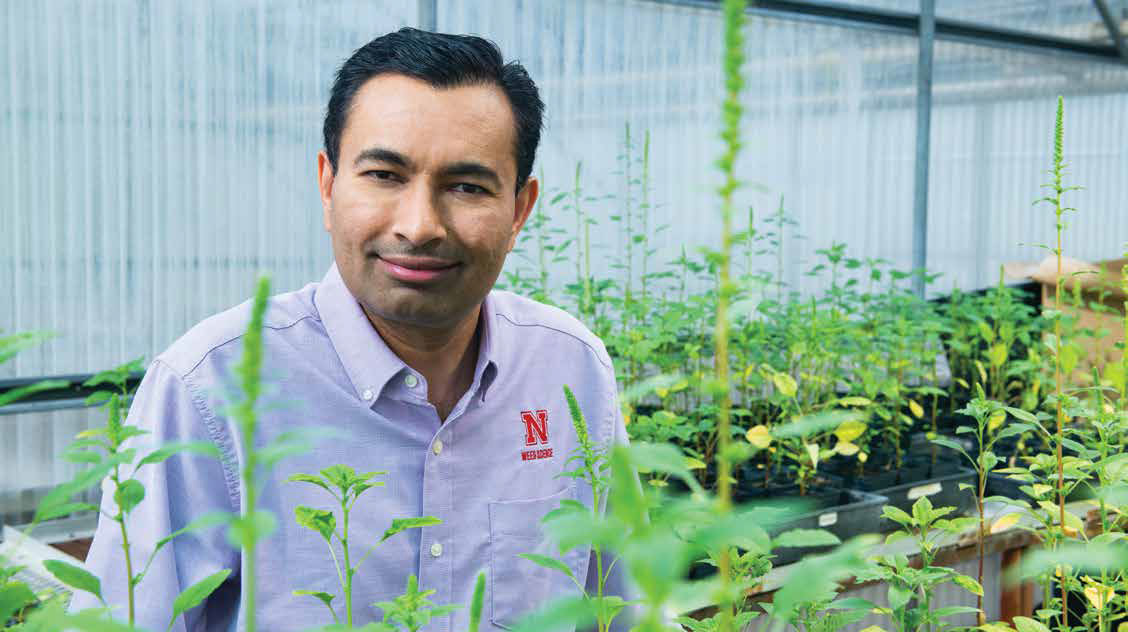
Herbicide-Resistant Weeds Are a Growing Problem
The Persistent Battle Against Weeds

Nebraska agriculture is a part of feeding the world, yet crop production continuously battles weeds. The use of herbicides — chemicals used to control unwanted weeds — is an important tool for growers as they rid weeds competing for resources. However, weeds are fighting back and becoming resistant to herbicides, which complicates herbicide options for weed control.
Amit Jhala, associate professor and Extension weed management specialist in the Department of Agronomy and Horticulture at the University of Nebraska–Lincoln, explained that when herbicides with the same site of action are used continually in a field, a weed could become resistant to herbicides designed to control it. “Any weed can evolve resistant to any herbicide if it is used repeatedly in the same field,” Jhala said.
According to Jhala, using herbicides as per the label recommendation is the most efficient method farmers have been using to control weeds and maintain a stable production system.
However, natural reproductive processes in weeds, such as pollen-mediated gene flow, where genetic information travels from one place to another through the movement of pollen, forces growers to consider numerous weed management methods. Jhala’s team works to find ways to mitigate this issue.
Why Herbicides?
Eastern Nebraska crops, such as corn, soybeans, sorghum and popcorn, compete with weeds for nutrients, water, light and space, according to Jhala. Herbicides are important for controlling weeds, and weed control is important to maintain optimum crop production. Jhala said that without weed management, crops would essentially be starved from a lack of resources they need, and growers would not be able to yield the same quantity or quality of crops. Therefore, weed control is not only important — it is necessary. Herbicides are a key tool to battle weeds.
“On average, landholding for a grower in Nebraska could be more than 3,000 acres. On that many acres, it is not possible to control weeds as efficiently by any other method than herbicides,” Jhala said. “That is why herbicides are the most important for weed control for corn and soybean producers in Nebraska.”
According to Jhala, herbicides provide the most efficient method to control weeds and their use is regarded as safe as long as the products are used as per the label recommendation. “As long as an herbicide is labeled, it is safe. If growers are using them as the label recommendation, it is safe,” Jhala said.
Jhala explained that every herbicide goes through a rigorous review process to determine if it is safe to bring to market. If approved, the industry works with the federal government to bring the herbicide to market. Each herbicide has a label, which is a legal document that includes information on how to use, how much to use and when to use the product. All information is mandated by the Environmental Protection Agency. One of the most popular herbicides — glyphosate — has historically been the most common and effective herbicide to control a number of weed species.
Herbicides, like glyphosate, specifically target weeds while keeping the crop safe (if crop is resistant to glyphosate such as glyphosate-resistant corn and soybean), according to Jhala. To do so, the crop needs to be resistant to the herbicide. The popularity of glyphosate increased significantly when scientists grew the first glyphosate-resistant corn and soybean. Farmers could spray glyphosate before or after the crop started growing and the crop would grow while killing the weeds. Growers have used glyphosate continuously for many years, which has caused weeds to become resistant to it.
Resistant Weeds
The difficult part about weed control is that some weeds grow resistant to herbicides designed to control them, according to Jhala. When a weed fails to respond to an herbicide, it is deemed “resistant” to that specific herbicide. If growers use a specific herbicide program year after year, eventually some weeds can evolve resistance and survive.
The first herbicide-resistant weed appeared in Nebraska in 1994, according to Jhala. In 2019, at least six weeds in Nebraska are resistant to glyphosate. Growers are forced to consider different herbicides and methods to maintain a consistent yield. Although these weeds are becoming harder to control, herbicides continue to be the best method to control weeds.
Pollen-Mediated Gene Flow
Jhala explained there are two primary ways that herbicide resistance travels from plant to plant or to another field — by seeds or pollen. When a crop is harvested, resistant weed seeds may be harvested with it. If so, those seeds can be transferred to another field by machinery. Jhala and his team have begun research on how pollen can carry genes and how it spreads resistance through pollen-mediated gene flow.
Although pollen naturally carries genetic information, Jhala’s team is one of the first studying it and how it carries resistance.
“It’s not something new,” Jhala said. “But nowadays, the research on pollen-mediated gene flow becomes very important because of the issue of resistant weeds and to know how rapidly it disseminates.”
Common waterhemp, a multiple herbicide resistant weed found across Nebraska, carries resistance through pollen.
“When a male plant of common waterhemp is resistant to an herbicide, and if the pollen from that resistant plant crosses with a female plant of common waterhemp that is not resistant to an herbicide, the seeds produced will be resistant to that particular herbicide because herbicide resistance is a dominant trait,” Jhala said. If resistance spreads, it forces growers to reevaluate their herbicide program to find a new herbicide or herbicide with alternate site of action.
The Future of Weed Control
While the fight against resistance continues, Nebraska still holds many agricultural advantages, according to Jhala. In eastern Nebraska, growers have access to irrigation facilities. Growers couple these resources with their knowledge of production agriculture to be leaders in the Midwest.
Nebraska is also the No. 1 popcorn-producing state in the country and produces about 45% of the total popcorn produced in the United States. Because of this, Jhala and his team have started to dig into weed control options in popcorn to make sure popcorn growers are reaping the benefits of research.
Corn and soybean growers can best fight resistant weeds by knowing what weed is in their field. Growers can access the 2019 Guide for Weed, Disease and Insect Management in Nebraska, a 300-page reference book with resources to manage weeds in number of crops grown in Nebraska, at https://marketplace.unl.edu/extension/ec130.html. Additionally, Jhala presents at winter Extension meetings and conducts Extension field days during June and July to educate growers about identification of weeds and their management (learn more at agronomy.unl.edu/jhala). He also writes articles for the Nebraska Extension website called CropWatch (https://cropwatch.unl.edu/), where growers can access real-time updates on crop information. These resources provide knowledge to better understand the weeds in fields and how to control them.
While the fight against resistant weeds is still persistent, Jhala and his team continue to seek solutions. For example, he and his colleagues are investigating multiple herbicide-resistant corn and soybean and their crop safety, cover crops for weed suppression, and use of UAVs for weed scouting and weed identification. His research helps the agricultural industry remain resilient against weed challenges and gives it the tools to find control.
“The greatest enjoyment of my role as an Extension specialist is to help and educate stakeholders for weed management in crops and answer on an average 400+ phone calls/e-mails every year to solve their problems,” Jhala said.